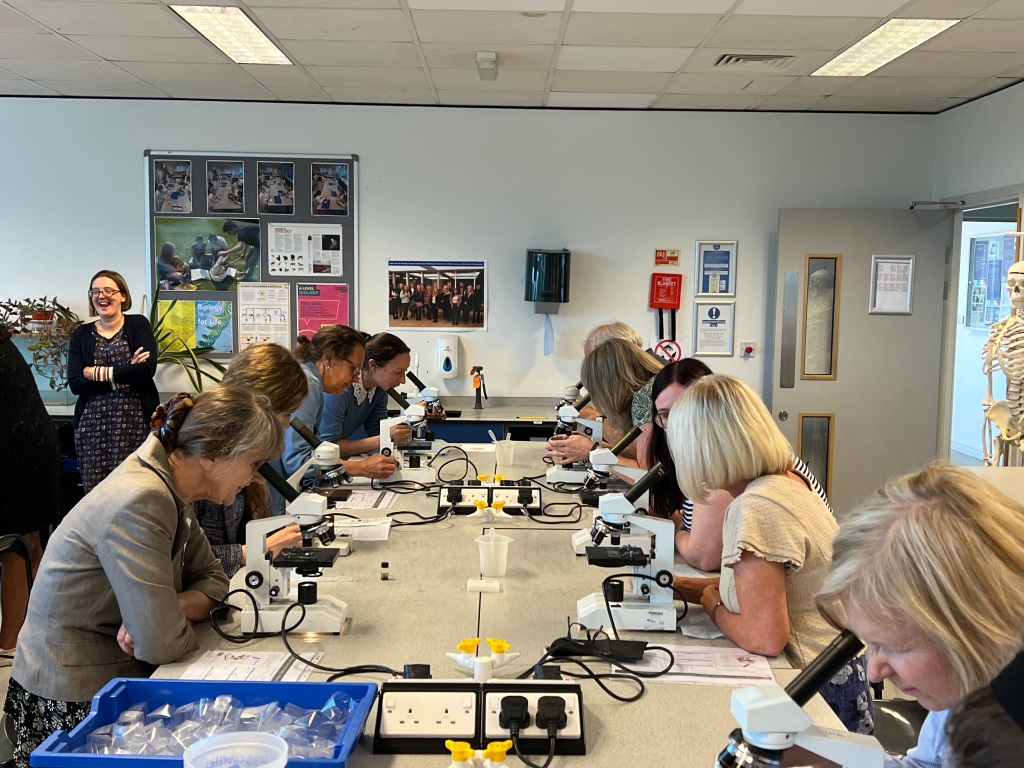I was honoured to be invited to give a Keynote at the Sussex and Surrey Science Learning Partnership (SLP) this week. Not only that, they asked me to run two Moss Safari sessions. Here’s what happened in the Moss Safari’s and the feedback from the science technicians.
School science technicians in England are the unsung heroes of science departments and they things running smoothly in school laboratories. This conference was the first face to face event many had been to since lock down and there was a great buzz of networking. Over fifty technicians from local schools met together at the Worthing Sixth Form and I was delighted to take them on a Moss Safari.
I ran two Moss Safari sessions for around twenty technicians at a time. I used my usual secondary school format of a brief introduction to moss as an extreme habitat and the Big Five. I then do a live demo, this time we only found a tardigrade egg (Figure 1) and one sleepy tardigrade (Figure 2).


Few, if any, of the participants had seen a tardigrade before and none, as yet, had done a Moss Safari activity. When questioned only a few of the technicians had heard of any of the moss dwelling organisms. They were given a pack with a Big Five identification sheet and some technician notes (Figure 3). These notes include how to do a bulk Moss Squeeze for larger groups.

The second part of the hour session was the technicians using microscopes to investigate a moss squeeze (Figure 4). During those sessions we found two species of tardigrade, a number of nematodes and several rotifers. No mites or gastroriches this time, but a host of single celled organisms and some unidentifiable curiosities.

So, what did they think?
Beyond my trainees, this was the first large group of adults that I have done a Moss Safari with. They were very focused on doing the Moss Safari themselves and quickly got looking down their eye pieces. They have the same curiosity, excitement and frustrations that youngsters experience. Curiosity of what they are seeing, excitement when they get one of the Big Five and frustrations of using a microscope, focusing and not finding anything!
There was lots of general positivity about the session and someone commented on my enthusiasm for the activity (I do really love doing it!). In the feedback, they provided some helpful insights (based on 15 responses).
All respondents strongly agreed that they found the session interesting, enjoyable and learnt something new. Identifying the highlights as including:
Seeing or finding a rotifer or nematode or tardigrade!
“Learning about all the interesting things in moss and how easy it is to have a look.”
“Learning about the different life forms and seeing them on the board”
“Finding the organisms myself”
“Knowing that there are living organisms in moss when I thought it was just green foliage”
“Having my mind opened to the amazing habitat that is moss”
All strongly agreed that they were inspired to do a Moss Safari themselves and recommend others to experience a Moss Safari like this one. With all agreeing that they were inspired to do a Moss Safari at work. Interestingly, half of the respondents said they would now consider buying a microscope for themselves or someone else.
They all found the Big Five Checklist helpful wrote things like, “Extremely useful as it gives you something to look for.” or “Very [useful] – to keep it manageable.” Which is the purpose of the Big Five Checklist.
I always ask for suggested improvements. A few would have liked longer looking at their own moss samples, one or two suggested more information on the other organisms they might see, including single celled organisms (that is work in progress!) and most said they were happy with it just as it was.
So, now I have hopefully given these wonderful technicians the confidence and inspiration to go into their schools and encourage teachers to do Moss Safaris with their students. All the resources are free and downloadable here. This includes a folder for technicians: the PowerPoint I used, the Big Five Sheets and the Preparation Instructions for technicians.
Thank you to Claire Davies at SLP for inviting me. To Narissa and Wendy, the science techs who organised, set up and cleared up at Worthing Sixth Form College. And to all the technicians that attended and made my day brighter. Welcome to Moss Safari.
If you do a Moss Safari please share your finds with me on Twitter @Mosssafari, I love seeing what you have found and helping out if you don’t know what you’ve found.
ACG